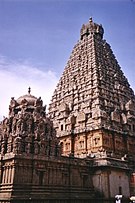| Part of a series on |
| History of Tamil Nadu |
|---|
 |
| Part of a series on the |
| History of Kerala |
|---|
The Early Pandyas of the Sangam period were one of the three main kingdoms of the Tamilakam (southern India), the other two being the Cholas, and Cheras Dynasty. As with many other kingdoms around this period (earlier than 200 BCE), most of the information about the Early Pandyas come to modern historians mainly through literary sources and some epigraphic, archaeological and numismatic evidence. The capital of the Early Pandyan kingdom was initially Korkai, Thoothukudi[1] and was later moved to Koodal (now Madurai) during the reign of Nedunjeliyan I.[2]
The kings of the Pandyan Dynasty are frequently mentioned in Sangam literature of the third century BCE and onwards, in literary works such as the Mathuraikkanci and other early Tamil literary works such as Cilapatikaram, which have been used by historians to identify their names and, to some extent, their genealogy. Nedunjeliyan II is referred to as the most popular warrior among the Early Pandyas, winning a battle at Talaialanganam against a coalition of forces from Cholas and Cheras and five other kingdoms. The early Pandyan kingdom extended between Travancore in the west, Vellaru river in the north and all the way to the ocean in the east and the south.[3]
The Early Pandyas had active maritime trade relationships with the west, a fact testified by western classical writers such as Pliny the Elder (1st century CE), Strabo, Ptolemy and the author of the Periplus.[4] The Pandyan country was well known for pearl fishery, with Korkai being the principal center of the trade. Some of the exports were pearls, spices, ivory and shells, while the imports included horses, gold, glass and wine.[5]
- ^ Geological Survey of India (1883). Memoirs of the Geological Survey of India. p. 80.
{{cite book}}: CS1 maint: numeric names: authors list (link) - ^ Iyengar. History of the Tamils: From the Earliest Times to 600 AD. p. 189.
- ^ Caldwell. A Political and General History of the District of Tinnevelly, in the Presidency of Madras. pp. 24–25.
- ^ Thinakaran. The Second Pandyan Empire. p. 8.
- ^ Krishnamurthy. Sangam Age Tamil Coins. p. 6.


